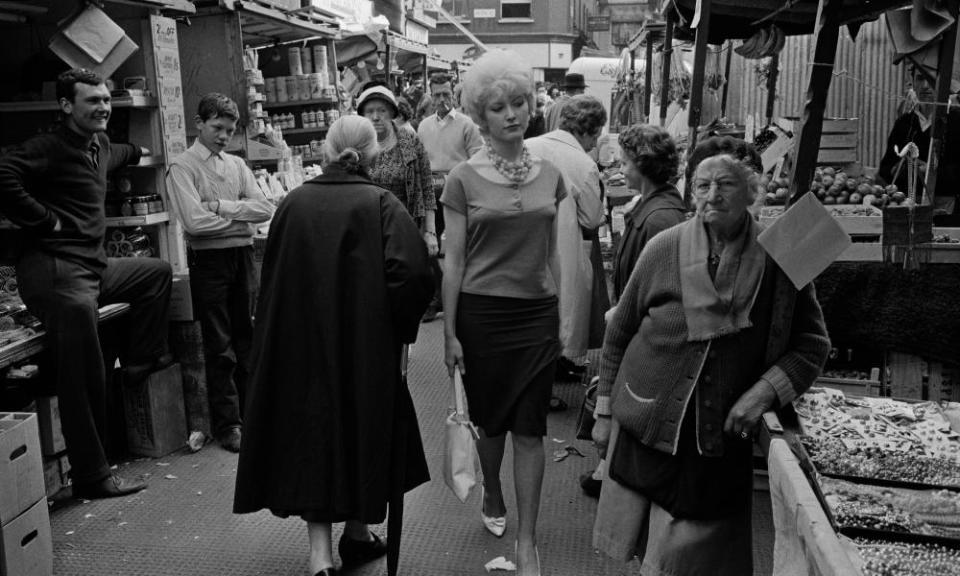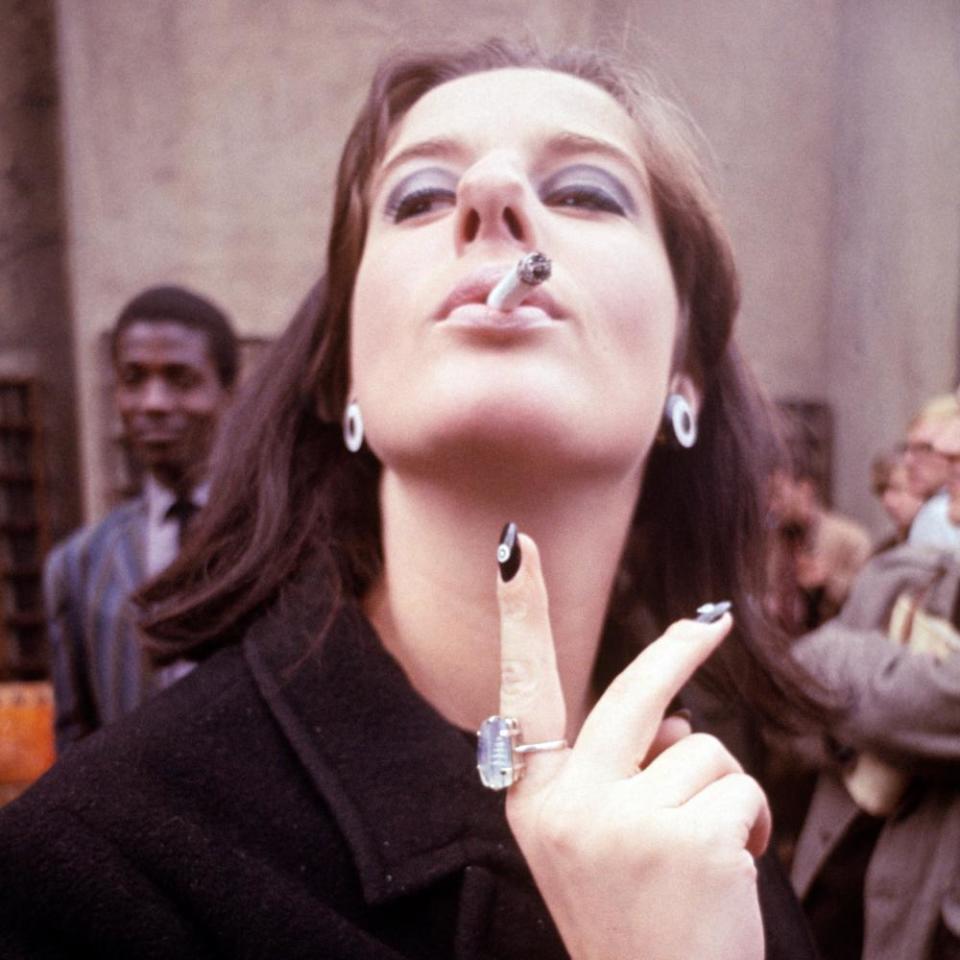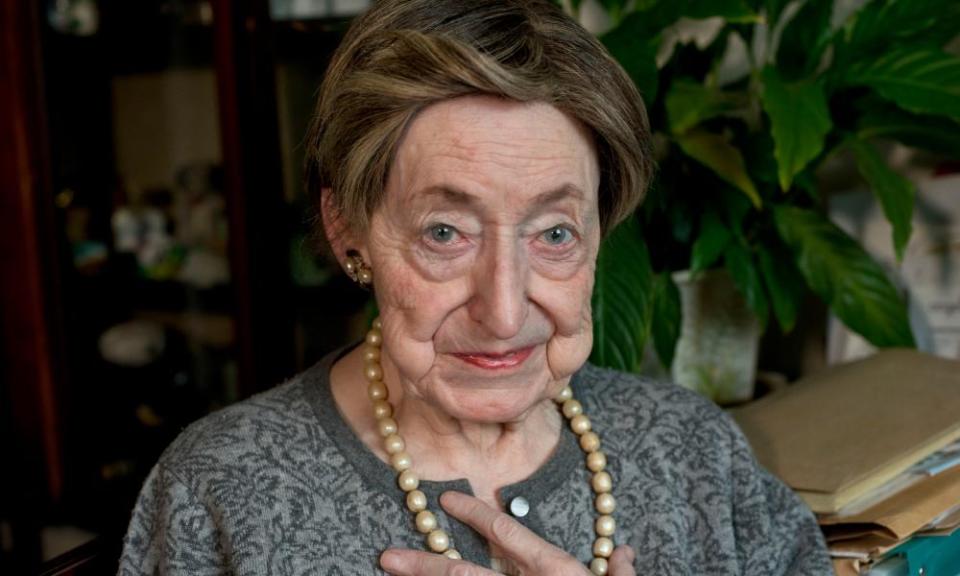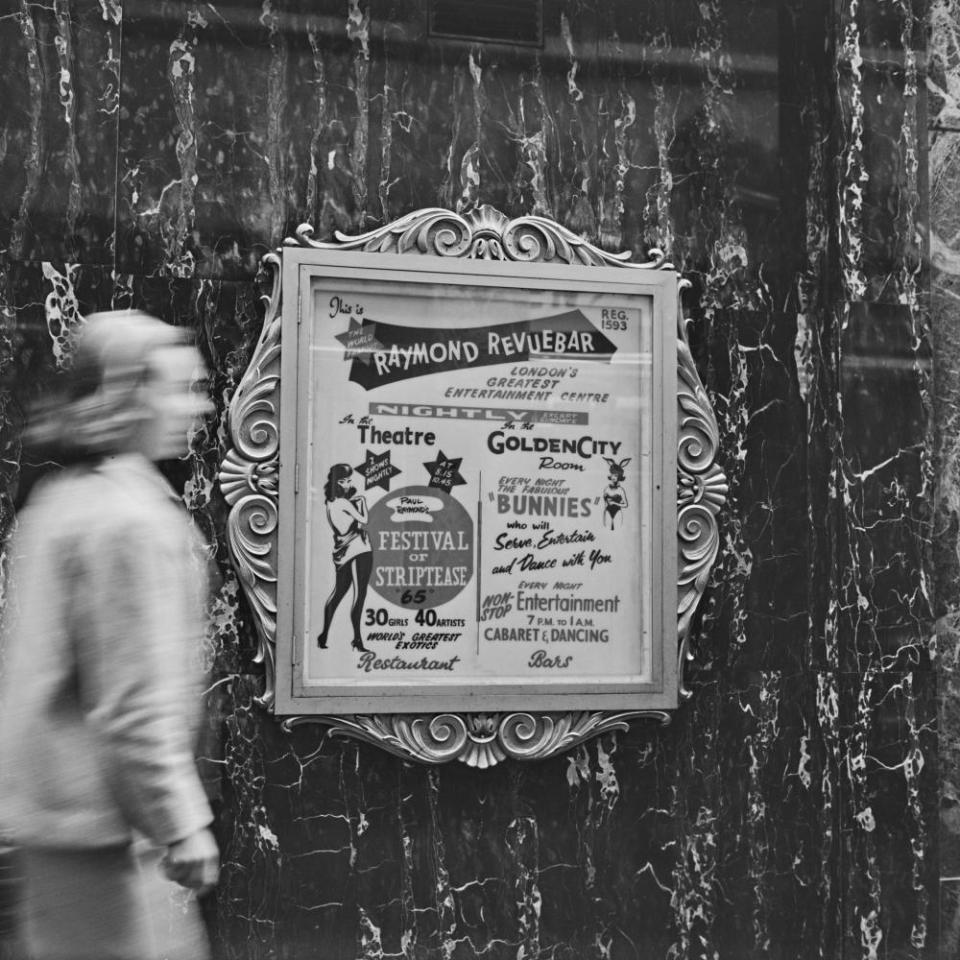Women in 60s Soho: ‘You were less judged. You could do what you wanted’

In her cosy sitting room, overlooking one of Soho’s busier streets, Jean Jones (not her real name) begins to peel off an imaginary skirt. “Someone made it for me,” she says. “It was red, and it had loads of panels. I used to take each panel off one at a time, like this.” With a flick of her hand, she flings first one invisible bit of scarlet satin, and then another, over her shoulder. What about her top half? She laughs. “I’m not big-busted, so we didn’t make a big thing of that. I wore a bra, I think. It was probably a bit see-through, with sequins. My stage name was Lollipop Girl, after the song.” She hums the old hit, under her breath. “Everyone knew me. People in the street would shout it out: ‘Hello, Lollipop!’” Are any of the clubs where she used to work still in business? “Only Sunset Strip [on Dean Street]. You can’t miss it. It’s quite funny. I pass it every day, on my way to Tesco.”
Jean, a former stripper, is in her 80s now, though you wouldn’t necessarily know it to look at her. It’s not only that her back is still so straight, something she attributes to her dancing years. It’s more that, in spite of everything, her appetite for Soho life remains so undimmed. “It’s the people,” she says. “I look out of the window, and I see people. When I walk down the street, it’s still: ‘Hi, hi, hi!’” Is Soho a better place now than when she first came here, or has something been lost since Westminster council set about clearing it up and rents duly rocketed? “It’s not better, or worse. It’s just different. A lot of people are sentimental. They say: do you remember the old days? Well, I do remember. But we’re here now, and that’s what matters.” In any case, she was perfectly happy taking her clothes off for money. “The other girls… oh, they were lovely! Cockneys, black girls, white girls. We used to giggle together at the back, and the money was good. It was better than being a shop assistant, and you only had to work a few hours in the evening.”
You kept moving, you took your gear with you. Undressed, dressed; undressed, dressed. Some girls did six clubs a night
The world that Edgar Wright brings so vividly to life in Last Night in Soho is beginning to fade a little now in her mind: the pictures are fuzzy, and it’s difficult always to make sense of them without recourse to – she squints at it, hard – a piece of paper on which she has scribbled furious notes. But yes, she was there, right in the middle of it all, having pitched up in London in 1965, as so many girls did, whether because they were running away from something, or just looking for excitement (she grew up on the Wirral, in a family that belonged to the Brethren Assembly, so perhaps it was both in her case). Harold Wilson was prime minister, the Krays had recently been arrested on suspicion of running a protection racket, and at the cinema, the Beatles film Help! had its premiere. In Hampstead, she lodged with an ex-boyfriend and, having no qualifications, picked up work wherever she could. Sometimes, she was an artist’s model, and sometimes, she travelled across London to have sex with men who responded to ads she placed – this was something she just “slipped into”, she says, though she knows this might sound odd – and it was on one of these assignments that she met John. “I remember it well,” she tells me. “He was supposed to be a client, but we just started giggling, and it was such a relief.” The two of them would be together for the next 20 years.
It was John who introduced her to Soho, that exuberant, half-glamorous, half-seedy chequerboard of streets where anything could – and often did – happen. “He knew what I did, and he suggested that I try striptease instead. It was safer than going to strangers’ homes, and I was a dancer, and a bit of a naturist, so I didn’t have any problems with nudity. Of course I was nervous. I’m not an extrovert. That’s why I started to drink: Dutch courage, just enough to get me on stage, and sometimes valium, too. But it wasn’t humiliating. In a way, it was quite innocent. The audience was in darkness. They were quiet. They never dared speak to you, or bother you. You had no trouble when you walked past them. They weren’t allowed to touch you or to give you tips, and whatever happened, you always had to keep your G-string on. That was the law.”
In his wonderfully evocative 1967 guide to the capital, London Dossier, the spy writer Len Deighton describes a typical Soho day; the way it changes, hour by hour. His account begins in the “strident, dusty” early morning when its pavements are littered with gleaming blocks of ice and the sound of clattering dustbin lids is close to deafening; moves busily through lunchtime, when the air begins to smell faintly of garlic and the chattering barrow boys are beginning to sell off their fruit and veg at knockdown prices; and finally culminates in anticipation of the long night, when band leaders arrive looking for spare trombonists to hire from among the musicians that hang around the corner of Archer Street.
By Deighton’s telling, there were all kinds of strip clubs in Soho by 1967, but the vast majority were grubby basements “where the walls are peeling at a faster rate than the dollies”. Such places, dingy and stage-less, were usually rented to a strip-club because the end of their lease was nearly up (no other business would be interested in such a short-term venture), and they kept their more or less continuous shows on the road by sharing the same girls, a gaggle that would “trot” through Soho “at a fast clip seldom pausing for a cup of coffee”, their faces thick with makeup and their costumes in little suitcases they carried in their hands. Does this sound right? Jean says that it does. “Paul Raymond had his Revuebar [it opened in Walker’s Court in 1958] and it was so successful. But his girls all worked only for him, together, and I wanted to work alone. So, yes, I was one of those other girls. You had to keep moving, and you took your gear with you. Undressed, dressed; undressed, dressed. Some girls did six clubs a night. I did three, usually.”

She would, she says, have been quite content to keep stripping, but by the time a bout of shingles had taken her out of it, she and John were living in Soho and thus well aware of all the other – how to put this? – opportunities available to them, whether legal or not. “We started a magazine called Way Out, which we posted to subscribers,” she says. The euphemistic small ad enjoyed its heyday in the 60s – the phrase “French lessons offered” had nothing whatsoever to do with the improvement of language skills – and like Soho’s shop windows and telephone boxes, Way Out was full of them. It also advertised “massage” sessions, and this enabled Jean, in fact a qualified masseur (“I still have the certificate”), to provide more than a back rub to anyone who booked her – which is how she ended up back where she’d started. Wasn’t this life dangerous? “Well, you had to suss the person out. But I’m very good at that: straight off, I can just know a person, especially men. I only had one bad encounter. I didn’t like him at all, and in the end I just said: sorry, I have to go.”
Life, though, was getting darker for Jean now, alcohol tightening its grip, and her relationship with John growing more troubled: “He had other women if he felt like it.” But it was hard to get out: perhaps they had the feeling that they were at the heart of things. At one point, John Bloom, the controversial entrepreneur best known for his role in the “washing machine wars” of 1962-3 (his plan, ultimately unsuccessful, was to empower consumers by cutting out retailers and selling his company’s twin tubs to them directly at vastly reduced prices) professed interest in buying Way Out. “I had a meeting with him at his flat in Park Lane,” she says. “He was in the bath!” Bloom knew David Bowie, and the Beatles and Shirley Bassey were among those who attended his parties. In the summer of 1962, at the height of his notoriety, he’d also begun an affair with a young married mother, Christine Holford, whose jealous husband, a Brighton club owner called Harvey Holford, would murder her that September. Holford’s trial was a tabloid sensation, though Bloom later claimed only to have met Christine twice.
Soon after this, Jean’s addiction finally got the better of her. She was admitted to a psychiatric hospital where she was injected with sedatives and put to sleep for a week (Deep Sleep Therapy was a popular psychiatric treatment in the 1960s and 70s). She and her partner John, however, would stay together until his death in the late 1980s, sharing a more normal kind of life in Soho – even if, ultimately, her drinking did continue (she didn’t win her battle with alcohol until the 1990s). “People don’t realise there is a residential community here,” she says. She worked as a doctor’s receptionist and as a dental assistant, and eventually she became a Christian.

Does she have any regrets? Not really. Gratitude is the thing: a person should count their blessings. What about John? Does it upset her now that he encouraged her to strip? That he didn’t mind when she went back to working as a prostitute? She shakes her head. “I thought nothing of it, really,” she says, softly. “I was going to do it anyway. It wasn’t complicated. Sex is sex, and men are men.” She knows that some women – far too many women, probably – were exploited in Soho. But she doesn’t necessarily feel that she was one of them.
“Soho was jollier then,” she says, pressing her hands together in the manner of someone recalling a marvellous party. “The coffee shops, and the pubs. The market. You could buy everything there.” She struggles to explain the feeling it gave her. All she knows is that it was a world unto itself: “When you were working, people would look at you, and that was fine. That was what you were there for. But then you came home, and you put on your normal clothes, and you were normal.”
* * *
In London Dossier, Eric Clark, a crime reporter deployed by Deighton to give the reader the full lowdown on Soho’s underbelly, writes that those who wander its streets are neatly divided into “sellers and suckers”. Into which category, I wonder, did Jean fall? And what about other women who worked there? Such a description doesn’t tally with everyone’s memory. In the 60s, the actor Dorothea Phillips held the licence to more than one Soho drinking club; as the daughter of a vicar and a university graduate, she was considered “terribly proper”, and thus was somewhat in demand as a name to put above the door in the eyes of some proprietors. “I was working in rep and in the West End,” she says. “Having a licence just meant going to the magistrate’s court once a year – and I knew him, actually, because he’d been at college with me. I started off at a place called the Irving, and then I had the licence for the Kismet, which was quite famous in its day. These were clubs that stayed open after the pubs closed. There were dozens of them in Soho, all filled with actors who went to them after they’d finished work.”
She was paid for her services to Kismet in free drinks: a delightful prospect for a not-necessarily-always-very-flush actor. It was, she tells me, a great place, but it was also – like a lot of Soho, she insists – one where there was rarely any trouble. “Downstairs, there were two bars. The one on the right was mostly full of cops and crooks, and the one on the left was used mostly by actors like Terence Stamp and Albert Finney and by painters like David Hockney and Francis Bacon.” What went on in these bars? “Well, drinking, obviously, and we used to sing songs. Someone would decide to have a quartet or something, because they knew could always find a tenor or a bass. In club hours, once the pubs had closed, the rule was that you were supposed to have something to eat, so there were always piles of sandwiches, too – not that most people bothered.”

Did she feel safe? Did things ever kick off? She looks at me as though I might be stupid. “Oh, darling. It was completely safe. I mean I used to walk around at two o’clock in the morning, and feel quite safe.” She was very tall and quite confident, and if any man had tried anything on, she would, she says, have kicked him good and hard between his legs, or stamped on him with one of her heels. “I have been known to knock people out,” she says, calmly.
People would have thought you were mad if you’d worn a twinset and pearls round here
As for gangsters, the area was very tightly controlled by the Italians and, particularly, the Maltese. “At one stage in the proceedings, I do remember that the Krays tried to take a place over,” she says, in her amazing voice, which though it still has the Rhondda at its edges (she grew up in Penygraig), mostly brings to mind the kind of old movie you might see on a wet afternoon on Talking Pictures TV. “But they didn’t last. I mean, they were more or less chucked out.” What did her father make of the fact that she was out and about in Soho until all hours? “Darling, my father would have been an actor himself if he hadn’t been a vicar. I don’t think he was in the least bit bothered.”
She has, she says, never found Soho sleazy (even now, in her 90s, she still travels every week from Bloomsbury, where she lives, to meet pals in the French House pub on Dean Street). “The underworld was there, of course. Everywhere has one; even Penygraig. I’m sure lots of terrible things went on, darling. But it had this respectability, too. I don’t know how to explain it, but I always found everybody to be absolutely proper. I was very fond of people like Paul Raymond. We used to have a little chat and a drink together, and he always behaved immaculately. The only one I really couldn’t stand was Ian Board, who ran the Colony Room [Francis Bacon’s favoured watering hole] after Muriel Belcher. He really was a shit, and he liked me about as much as I liked him.”
Dottie doesn’t use words like liberated or independent – she hardly needs to – but Jane Doyle, who worked at another actors’ club called Gerry’s in the 60s (it still exists, though it’s currently closed, thanks to a flood), is explicit: for girls like her, Soho represented freedom. “I came to London from Lancashire when I was 16,” she says. “I worked as a secretary at first, and I lived above the Phoenix theatre on the Charing Cross Road. The world [for women] in those days was all debs’ delight and dinner parties, but in Soho, you were less judged. You could get on and do what you wanted. People would have thought you were mad if you’d worn a twinset and pearls round here.” (She still lives in Soho.)

Gerry’s was run by Gerald Campion, best known for having played Billy Bunter in a 1950s television adaptation of the Greyfriars school stories; its customers included Tony Hancock, Michael Caine and Ray Galton and Alan Simpson, the writers of Steptoe and Son. “It was quite small,” she says. “Some people were in there all the time, and some came and went according to when they were in town. Food was served – cheap and cheerful food like sausage and mash – but it was really a place where famous people could get pissed without anyone taking much notice.” What was Soho like? Did she feel safe walking home? “There was always the sleaze and the sex, but the Maltese ran it – and the Swiss, less obviously. They bought up cheap properties, and they saw ways to make money out of protection. There were criminals. Keith Waterhouse and Willis Hall [the writers] used to go to Gerry’s a lot, and a well-known villain, Jimmy Humphreys [a pornographer who owned a Soho strip club], was giving them background for the series that would become Budgie [starring Adam Faith]. But it always felt safe. They left you alone.”
And what about now? As a member of the board of the Soho Society, Jane is, she admits with a smile, obliged to say that it is a good thing the sex industry has more or less disappeared. But she misses the old sense of community: “The market people used to really look out for their regulars.” What’s left? Like Dottie, she still visits the French House, and she still uses I Camisa & Son, the Italian deli that has stood on Old Compton Street since 1961: “They do wonderful pesto.” Mention of this, I think, puts ideas in both our heads, and after finishing the coffee that we’re drinking, on a pavement half-deafened by the endless building work at the top of Charing Cross Road, we head in its direction. It’s a warm day. People are out and about. In Soho Square, we see skateboarders and dog walkers and rosy-faced drinkers. No ghosts, or not that I notice. But in the air there still hangs that heady mixture of promise and disappointment, hope and resignation; we walk through a never-ending morning after the night before.

 Yahoo Finance
Yahoo Finance 